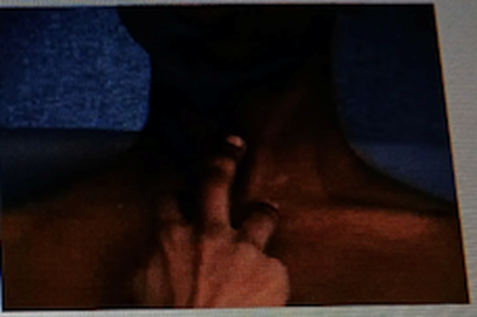A nurse palpates the neck using a three finger technique. what is the nurse assessing?

Trachea is midline
Location of the thyroid
Location of lymphnodes
Ability for client to swallow
The Correct Answer is B
A) Trachea is midline: Palpating the neck using a three-finger technique is not typically used to assess the position of the trachea. The trachea's position is assessed by placing one finger on each side of the trachea and gently palpating to check for any deviation from the midline. This technique is different from using three fingers to assess the thyroid.
B) Location of the thyroid: The three-finger technique is often used by nurses to palpate the thyroid gland. This method helps assess the size, shape, and consistency of the thyroid as well as to check for any enlargement (goiter) or tenderness. The technique is used to help guide the nurse’s fingers to the correct area for palpating the thyroid gland, typically located just below the Adam’s apple in the neck.
C) Location of lymph nodes: The location of lymph nodes is assessed by palpating different areas of the neck using the pads of the fingers or a gentle circular motion. The three-finger technique is not typically used to assess lymph nodes. Instead, lymph nodes are individually palpated with one or two fingers to feel for enlargement or tenderness.
D) Ability for client to swallow: Swallowing ability is assessed by observing the patient while they swallow fluids or food and by asking about any difficulty with swallowing (dysphagia). The three-finger technique does not assess swallowing directly; it is a method used for palpating structures in the neck like the thyroid.
Nursing Test Bank
Naxlex Comprehensive Predictor Exams
Related Questions
Correct Answer is B
Explanation
A) Expected finding: Cotton wool spots are not considered an expected finding during a routine eye exam. These spots are indicative of underlying pathology, and their presence typically suggests an abnormality that warrants further investigation. They are not part of normal eye anatomy or typical health.
B) Unexpected finding: Cotton wool spots are small, white, fluffy lesions in the retina that occur due to microinfarctions of retinal nerve fibers. Their presence is considered an unexpected or abnormal finding during an ophthalmoscopic exam and can be associated with several conditions, including diabetes, hypertension, and other systemic diseases that affect blood flow to the retina. Their appearance is a signal of potential underlying health issues that require attention.
C) Expected variation: Cotton wool spots are not a variation of normal anatomy or function. They are pathological and should not be regarded as a normal variation of retinal appearance during an eye exam.
D) Irrelevant: The term "irrelevant" is not applicable in this context, as the presence of cotton wool spots is highly relevant to the clinical assessment. Their discovery suggests a need for further investigation into the patient's overall health, particularly cardiovascular or systemic conditions.
Correct Answer is D
Explanation
A) 2 mm: A pupil size of 2 mm would be considered small and is generally indicative of miosis, which can occur due to certain medications, increased intracranial pressure, or other factors. A size of 2 mm is not typically expected as a normal finding for pupil size in healthy individuals.
B) 6 mm: While 6 mm is within the upper normal range for pupil size, it is on the larger end. Pupils usually range from 3 mm to 6 mm in size under normal lighting conditions. However, pupils dilating to 6 mm can occur in response to low light conditions or sympathetic stimulation.
C) 8 mm: A pupil size of 8 mm would be considered dilated (mydriasis) and is abnormal under normal lighting conditions. Such a large pupil may suggest conditions like drug use, neurological issues, or other medical concerns that need to be assessed.
D) 4 mm: A pupil size of 4 mm is considered a normal and expected finding under standard lighting conditions. It falls within the typical range for adult pupil size and reflects a healthy, functional response to ambient light conditions. This size is within the commonly observed range for normal pupils.
Whether you are a student looking to ace your exams or a practicing nurse seeking to enhance your expertise , our nursing education contents will empower you with the confidence and competence to make a difference in the lives of patients and become a respected leader in the healthcare field.
Visit Naxlex, invest in your future and unlock endless possibilities with our unparalleled nursing education contents today
Report Wrong Answer on the Current Question
Do you disagree with the answer? If yes, what is your expected answer? Explain.
Kindly be descriptive with the issue you are facing.
